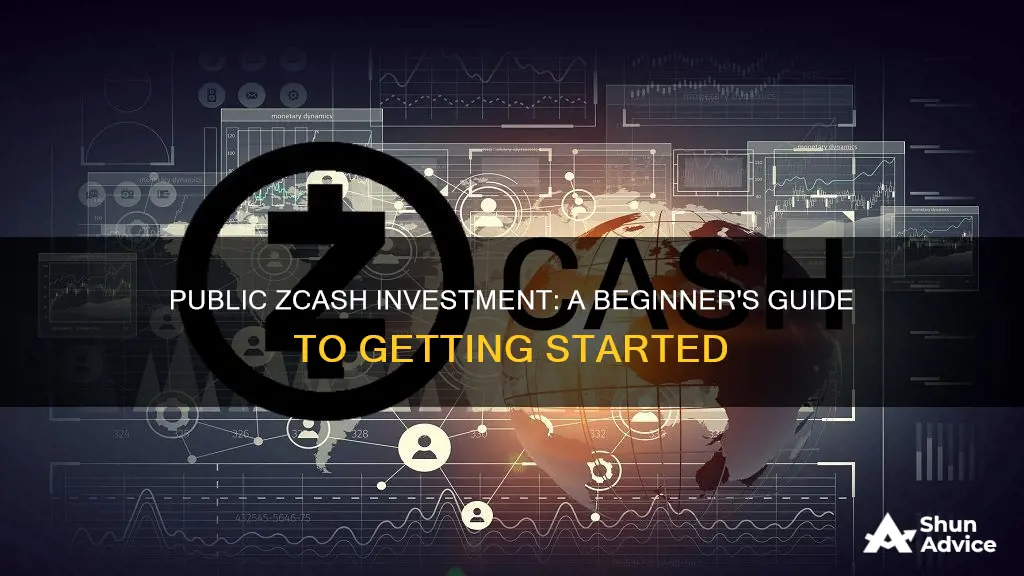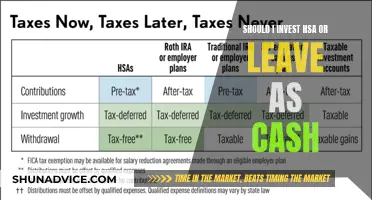
Zcash is a blockchain and cryptocurrency that was created in 2016 by a group of scientists who wanted to develop a cryptocurrency similar to Bitcoin but with enhanced security and anonymity. Zcash is a fork of the Bitcoin blockchain that uses the zk-SNARK security protocol to verify transactions without revealing any information to the network.
Zcash offers shielded and transparent transactions. Shielded transactions are encrypted and private, while transparent transactions work in a similar way to Bitcoin transactions.
There are several ways to invest in Zcash, including buying Zcash through an exchange, buying fractions of Zcash, trading Zcash through a broker, and investing in a Zcash ETF. When investing in Zcash, it is important to consider the fees, payment methods, and risks associated with each platform.
What You'll Learn

How to buy Zcash on an exchange
Step 1: Create a Zcash Wallet
The first step in investing in Zcash is to create a Zcash wallet to store your coins. You can either download the official Zcash client wallet or choose from a limited selection of third-party wallets. The official Zcash wallet is compatible with Linux, Windows, and MacOSX, and supports Zcash features, so it is a good option.
There are several types of Zcash wallets:
- Internet wallets: These can be downloaded for desktops and mobile phones. It is important to use strong passwords and enable two-factor authentication. Examples include Coinspot, Jaxx, and Freewallet.
- Hardware wallets: These are considered the safest way to store Zcash coins, but they are expensive and only support Zcash transparent addresses. Examples include TREZOR and Ledger.
- Local wallets: These are more technical to use, but they support Zcash's private addresses. It is important to frequently back up the wallet.
- Exchange wallets: These are available, but none support Zcash's privacy features, and they are less secure than other options.
Step 2: Buy Zcash (ZEC)
Once you have set up your wallet, you can purchase ZEC in two ways: with fiat currencies or with Bitcoin/Ethereum.
Buying with Fiat Currencies:
Some exchanges allow you to buy Zcash with USD or EUR. Examples include HitBTC and CEX.IO.
Buying with Bitcoin or Ethereum:
If you already have Bitcoin or Ethereum, you can exchange it for Zcash on platforms like Binance or HitBTC. First, you will need to fund your account with BTC or ETH. Then, search for ZEC/BTC or ZEC/ETH, enter the amount you want to buy, and click "Buy ZEC".
Step 3: Join a Crypto Exchange
To buy Zcash, you will need to join a cryptocurrency exchange. Examples of popular crypto exchanges include Binance, OKEx, and Huobi.
After choosing an exchange, you will need to register an account and complete the Know Your Customer (KYC) process, which may involve providing a photo ID and a selfie. Then, you can fund your account using various payment methods, such as bank transfers or credit/debit cards.
Step 4: Buy Zcash
Once your account is funded, you can purchase ZEC on the exchange. After buying your coins, it is recommended to move them to your private wallet for safekeeping.
Additional Considerations:
When choosing an exchange and payment method, consider the fees involved. Also, keep in mind that the crypto market is not well-regulated, so it is important to do your due diligence to avoid scams.
Additionally, always prioritize the security of your Zcash holdings. Enable two-factor authentication and consider using a hardware wallet or cold storage for extra security.
Cash Flow Analysis: Key to Investment Decision-Making
You may want to see also

How to store Zcash in a wallet
Zcash (ZEC) is a blockchain and cryptocurrency that emerged in 2016. It is a fork of the Bitcoin blockchain with enhanced user security and anonymity.
There are two types of crypto wallets that can be used to store Zcash: software and hardware wallets. Software wallets are easily accessible as they are mostly online and come in the form of websites, mobile apps, and desktop applications. Examples of software wallets include Guarda, BitGo, MetaMask, Exodus, and Atomic wallet.
On the other hand, hardware wallets store your coins safely offline. They are physical devices that resemble USB flash drives and store apps that can be used to hold your private keys. They are ideal for long-term investors and individuals that hold large amounts of a given digital currency. Examples of hardware wallets include Ledger, Trezor, Corazon, and KeepKey.
- Purchase a wallet: Choose between a software or hardware wallet based on your needs and preferences.
- Set up an account: If you are using a software wallet, you may need to set up an account and complete a Know Your Customer (KYC) process by providing identification details.
- Fund the account: Use various payment modes supported by the wallet to fund your account.
- Buy ZEC: Use the funds in your account to purchase ZEC on a cryptocurrency exchange.
- Transfer ZEC to your wallet: After purchasing ZEC, transfer it from the exchange to your private wallet.
It is important to note that before choosing a wallet, you should ensure that it supports Zcash and offers the desired level of security and privacy for your transactions. Additionally, always remember to keep your private keys secure and consider using a hardware wallet for added security.
Cash Investment: Revenue or Asset?
You may want to see also

How to spend Zcash
Zcash is a privacy-focused cryptocurrency, offering users the option of selective disclosure for auditing purposes. It was created in 2016 by a group of scientists who wanted to develop a cryptocurrency similar to Bitcoin but with enhanced security and anonymity.
- Paying friends and family: Zcash can be used to privately pay a friend or family member.
- Sending money overseas: You can use Zcash to send money to another country.
- Purchasing everyday items: Zcash can be spent on everyday items, such as groceries. Third-party apps like Flexa SPEDN allow users to spend Zcash at retailers like Lowe's, Nordstrom, and Baskin Robbins. Services like Moon enable users to make online purchases with Zcash wherever Visa is accepted.
- Donations: Zcash can be used to donate to various causes and support Zcash creators.
When spending Zcash, it is recommended to use an exchange that supports shielded withdrawals to fund your ZEC wallet.
How Cash Investments Impact Owners' Equity
You may want to see also

How to mine Zcash
To mine Zcash, you'll need to follow these steps:
- Install video card drivers: Follow the instructions laid out by your GPU card provider to install the latest driver version.
- Get a Zcash wallet address: It's recommended to use a hardware wallet for added security.
- Download a Zcash mining program: The EWBF Miner is a popular option, but there are other programs available.
- Tweak Windows settings: Prevent your computer from going into sleep mode, modify your system page file, and turn off automatic updates. You may also need to add an exclusion to your antivirus program.
- Join a mining pool: Choose a Zcash mining pool, such as Flypool, and follow their instructions to configure your miner.
- Start mining: Double-click your batch file to begin the mining process.
It's important to note that Zcash mining requires significant computational power and electricity, which can result in high costs. Additionally, profitability can vary due to factors like electricity rates and the price of Zcash. Therefore, it's essential to perform thorough research and calculations before investing in any mining equipment.
A Guide to Investing in Cash-Flow Websites
You may want to see also

How to choose a Zcash broker
When choosing a Zcash broker, it is important to consider a few key factors to ensure a safe and seamless trading experience. Here are some essential guidelines to help you select a suitable Zcash broker:
- Regulation and Security: Opt for brokers that are regulated by leading financial authorities, such as the SEC in the US. Regulation provides an extra layer of protection for your investments. Additionally, look for brokers that implement robust security measures, like two-factor authentication and cold storage of assets, to safeguard your funds from potential threats.
- Trading Options: Different brokers offer various trading instruments and derivatives, including CFDs (Contracts for Difference), futures, and options. Consider your trading strategy and preferences, then choose a broker that provides the trading options you require.
- Fees and Charges: Brokers typically charge trading fees, deposit/withdrawal fees, and other associated costs. Compare the fee structures of different brokers to find one that suits your budget and helps you maximise your profits. Some brokers, like eToro, even allow US clients to add funds to their accounts for free when using a debit/credit card.
- User-Friendliness: If you're a beginner, opt for a broker with a user-friendly interface that simplifies the trading process. Look for platforms with intuitive navigation, straightforward order placement, and accessible educational resources to help you get started.
- Payment Methods: Ensure that your chosen broker supports your preferred payment methods, such as bank transfers, credit/debit cards, or e-wallets. Some brokers may offer a wider range of payment options, making it more convenient for you to fund your account.
- Customer Support: Choose a broker that provides reliable and responsive customer support. This is crucial in addressing any technical issues or queries you may have during the trading process.
- Reputation and Reviews: Research the reputation of the broker by reading reviews from other users. This can give you insights into their experiences with the platform's reliability, security, and overall performance.
By considering these factors and conducting thorough research, you can make an informed decision when choosing a Zcash broker that aligns with your trading needs and goals.
Cash App Investing: Are There Any Fees Involved?
You may want to see also







